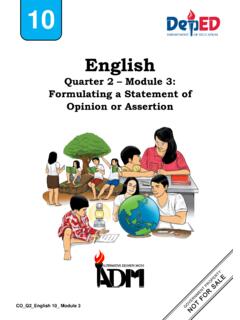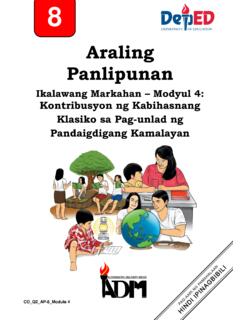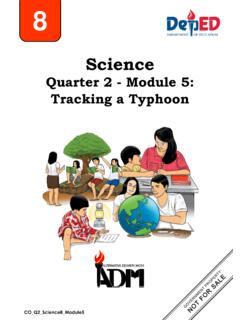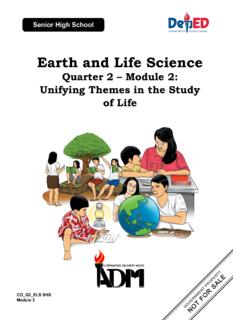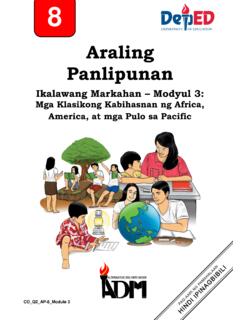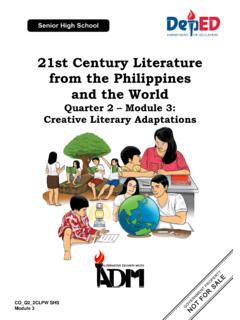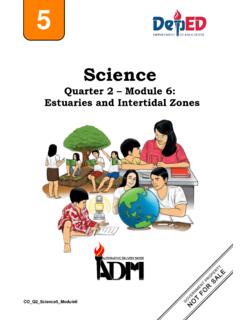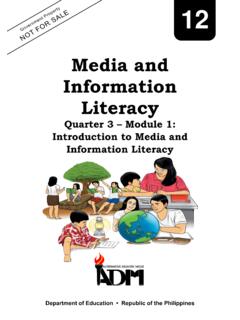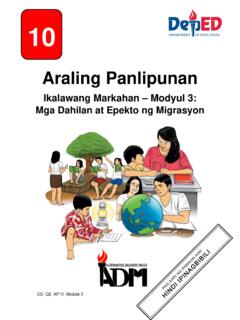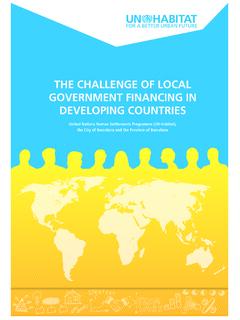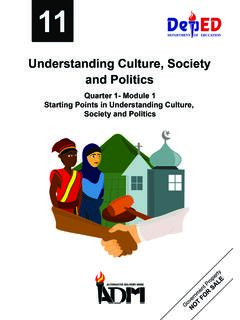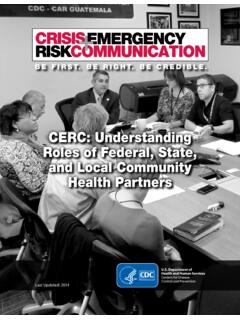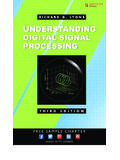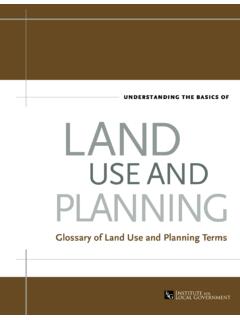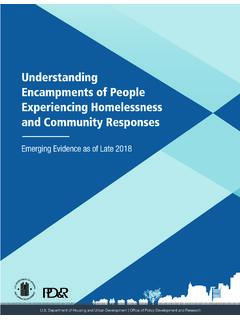Transcription of Understanding Culture, Society, and Politics
1 Understanding Culture, Society, and Politics Quarter 2 Module 1: State and Non-state Institutions Understanding Culture, Society, and Politics Senior High School Alternative Delivery Mode Quarter 2 Module 1: State and Non-state Institutions First Edition, 2020. Republic Act 8293, section 176 states that: No copyright shall subsist in any work of the government of the Philippines. However, prior approval of the government agency or office wherein the work is created shall be necessary for the exploitation of such work for a profit. Such agency or office may, among other things, impose as a condition the payment of royalties. Borrowed materials ( , songs, stories, poems, pictures, photos, brand names, trademarks, etc.) included in this module are owned by their respective copyright holders. Every effort has been exerted to locate and seek permission to use these materials from their respective copyright owners.
2 The publisher and authors do not represent nor claim ownership over them. Published by the Department of Education Secretary: Leonor Magtolis Briones Undersecretary: Diosdado M. San Antonio Development Team of the Module Writer: Mekisa V. Amores Editors: Leuvina D. Erni Dr. Imelda V. Boquiren Reviewers: SDO Pasay LRMS Team Illustrator: Edivin Kevin D. Abella Layout Artist: Bureau of Learning Resources and the Authors; SDO LRMS Team and the Authors Management Team: Malcom S. Garma, Director IV. Genia V. Santos, CLMD Chief Dennis M. Mendoza, Regional EPS In-Charge of LRMS. Micah S. Pacheco, Regional ADM Coordinator Loreta B. Torrecampo, CESO V, Schools Division Superintendent Librado F. Torres, CID Chief Normina B. Hadji Yunnos, Division EPS In-Charge of LRMS. and Division ADM Focal Person Printed in the Philippines by _____. Department of Education National Capital Region Office Address: Misamis St.
3 , Bago Bantay, Quezon City _____. Telefax: 02-929-0153. _____. E-mail Address: _____. Understanding Culture, Society, and Politics Quarter 2 Module 1: State and Non-state Institutions This instructional material was collaboratively developed and reviewed by educators from public and private schools, colleges, and or/universities. We encourage teachers and other education stakeholders to email their feedback, comments, and recommendations to the Department of Education at We value your feedback and recommendations. Introductory Message For the facilitator: Welcome to the Understanding Culture, Society, and Politics Alternative Delivery Mode (ADM) Module on State and Non-state Institutions. This module was collaboratively designed, developed, and reviewed by educators both from public and private institutions to assist you, the teacher or facilitator in helping the learners meet the standards set by the K to 12 Curriculum while overcoming their personal, social, and economic constraints in schooling.
4 This learning resource hopes to engage the learners in guided and independent learning activities at their own pace and time. Furthermore, this also aims to help learners acquire the needed 21st-century skills while taking into consideration their needs and circumstances. In addition to the material in the main text, you will also see this box in the body of the module: Notes to the Teacher. This contains helpful tips or strategies that will help you in guiding the learners. As a facilitator, you are expected to orient the learners on how to use this module. You also need to keep track of the learners' progress while allowing them to manage their learning. Furthermore, you are expected to encourage and assist the learners as they do the tasks included in the module. ii For the learner: Welcome to the Understanding Culture, Society and Politics ' Alternative Delivery Mode (ADM) Module on State and Non-state Institutions!
5 The hand is one of the most symbolized parts of the human body. It is often used to depict skill, action, and purpose. Through our hands, we may learn, create, and accomplish. Hence, the hand in this learning resource signifies that you as a learner are capable and empowered to successfully achieve the relevant competencies and skills at your own pace and time. Your academic success lies in your own hands! This module was designed to provide you with fun and meaningful opportunities for guided and independent learning at your own pace and time. You will be enabled to process the contents of the learning resource while being an active learner. This module has the following parts and corresponding icons: What I Need to Know This will give you an idea of the skills or competencies you are expected to learn in the module. What I Know This part includes an activity that aims to check what you already know about the lesson to take.
6 If you get all the answers correct (100%), you may decide to skip this module. What's In This is a brief drill or review to help you link the current lesson with the previous one. What's New In this portion, the new lesson will be introduced to you in various ways such as a story, a song, a poem, a problem opener, an activity, or a situation. What is It This section provides a brief discussion of the lesson. This aims to help you discover and understand new concepts and skills. What's More This comprises activities for independent practice to solidify your Understanding and skills of the topic. You may check the answers to the exercises using the Answer Key at the end of the module. What I Have Learned This includes questions or blank sentences/paragraphs to be filled into the process of what you learned from the lesson. What I Can Do This section provides an activity that will help you transfer your new knowledge or skill into real-life situations or concerns.
7 Iii Assessment This is a task that aims to evaluate your level of mastery in achieving the learning competency. Additional Activities In this portion, another activity will be given to you to enrich your knowledge or skill of the lesson learned. This also tends to the retention of learned concepts. Answer Key This contains answers to all activities in the module. At the end of this module, you will also find: References This is a list of all sources used in developing this module. The following are some reminders in using this module: 1. Use the module with care. Do not put unnecessary mark/s on any part of the module. Use a separate sheet of paper in answering the exercises. 2. Do not forget to answer What I Know before moving on to the other activities included in the module. 3. Read the instruction carefully before doing each task. 4. Observe honesty and integrity in doing the tasks and checking your answers.
8 5. Finish the task at hand before proceeding to the next. 6. Return this module to your teacher/facilitator once you are through with it. If you encounter any difficulty in answering the tasks in this module, do not hesitate to consult your teacher or facilitator. Always bear in mind that you are not alone. We hope that through this material, you will experience meaningful learning and gain a deep Understanding of the relevant competencies. You can do it! iv What I Need to Know This module is created with diverse learners in mind. Thus, the activities and reading materials made hold the intention to help students analyze the function of state and non-state institutions and their implications on the lives of people in society. Moreover, the topic under state institutions is divided into four lessons such as: a. Political and Leadership Structures b. Economic Institutions Then, the Lesson on non-state institutions will include the discussion of its five diverse classifications such as: a.
9 Banks and Corporations b. Cooperative and Trade Unions c. Transnational Advocacy Groups d. Development Agencies e. International Organization . Lastly, after going through the module, you are wished to: a. Explain the concept of redistribution using your own experience. b. Classify and identify the Non-state Institution in the Society. c. Reflect and familiarize important concepts about social functions of Non-state Institutions to the Society and People d. Conceptualize a perspective towards the social implication of the Non-state Institution to the community. 1. What I Know TEST I: MULTIPLE CHOICE. DIRECTIONS: Read each question carefully and write only the letter of the correct answer in the space after each sentence. Choices for ITEMS 1-5. A. Generalized Reciprocity B. Balanced Reciprocity C. Negative Reciprocity D. Reciprocity 1. A form of transaction which utilizes gesture that expresses personal relationships is known as _____.
10 2. Individuals involved in this transaction desire to gain as much as probable while paying the least amount possible. The transaction between both parties is identified as_____. 3. What type of transaction exists when the giver is expected to gain something in return although it does not have to be instant? _____. 4. As the eldest, Mariel provides educational assistance to her sister Karen. This form of transaction is known as: _____. 5. It is known as the transaction between two socially equal parties having the same status about the values of goods or services. _____. Choices for ITEMS 6-10. A. Power B. Authority C. Political Structure D. Charismatic Authority 6. It is known as the organized way in which power is allocated and decisions are made within society. _____. 7. The capacity to realize desired ends despite opposition from others is identified as. _____. 8. According to Weber, the power that people perceive as legitimate rather than coercive is categorized as.
